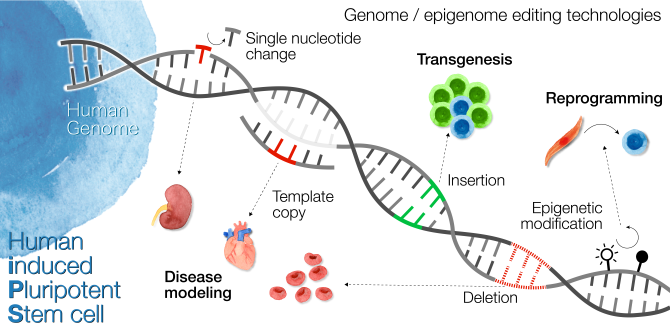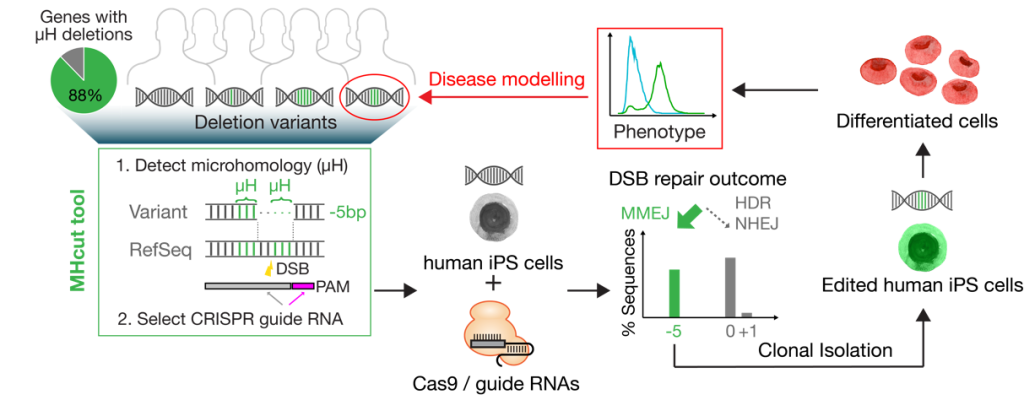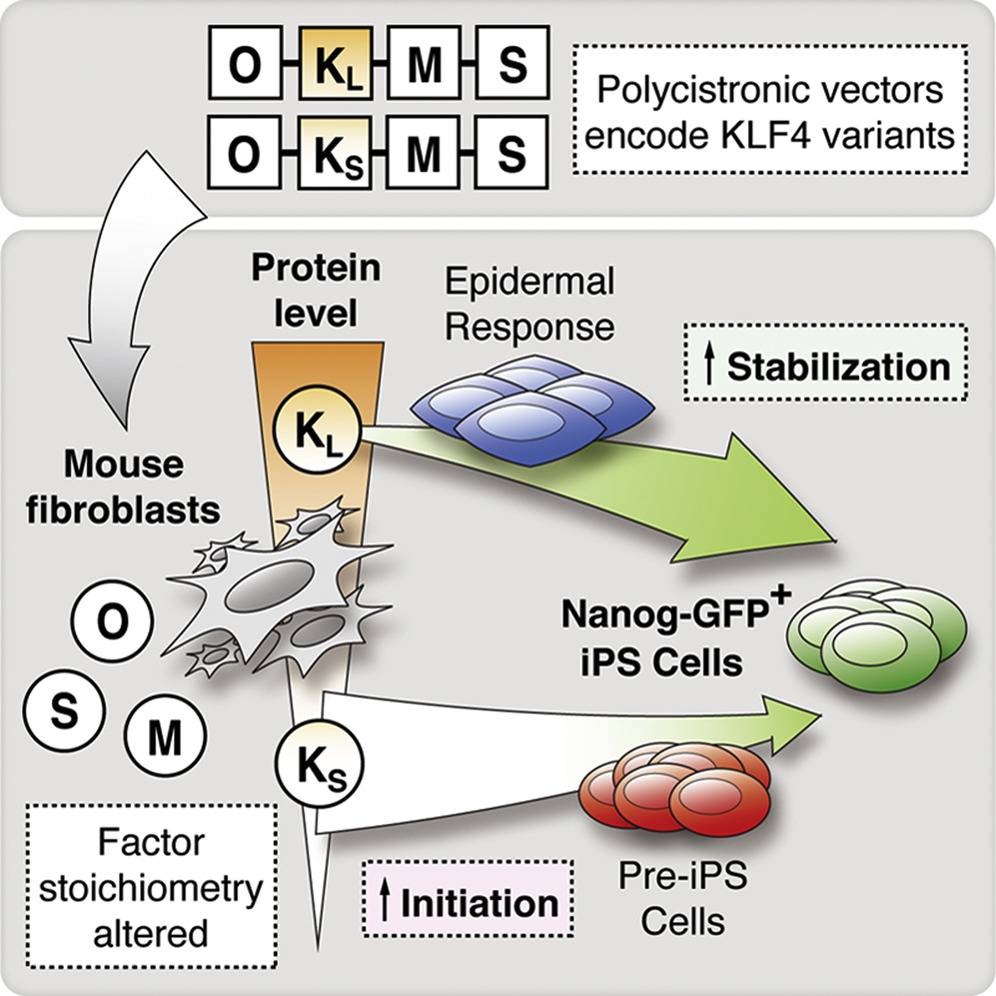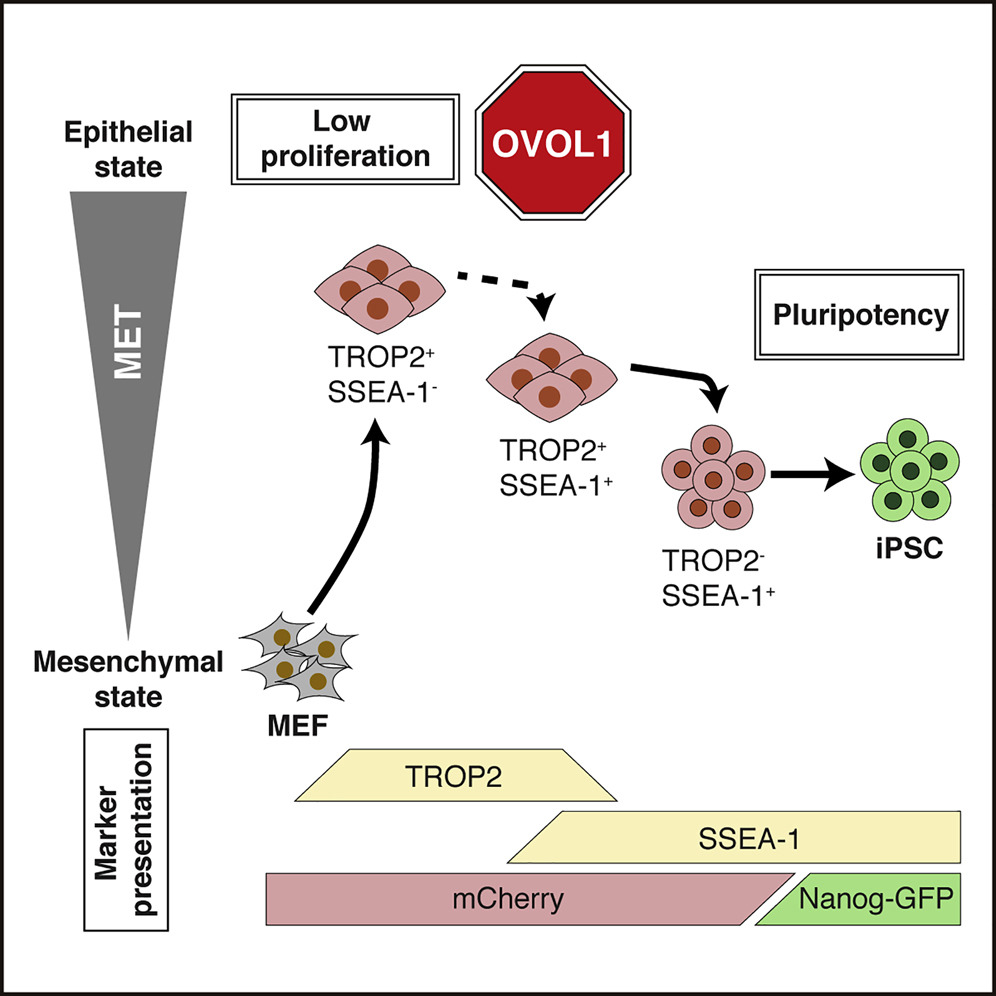Research
The Woltjen Lab develops and deploys cutting-edge gene-editing technologies in iPSCs to study and gain “total control of the human genome”. Our goal is to understand the genome and master techniques required to correct mutations and append new gene functions. Towards this goal, the Woltjen Lab developed methods to precisely edit single-nucleotides and create deletions, the two most common classes of pathogenic human genetic variants. Furthermore, we are establishing precise editing of repetitive DNA sequences which are highly variable throughout human evolution and amongst individuals. Our research addresses significant technical hurdles towards understanding genome function.
Click on any of the DNA edits to learn more!

Precision Gene Editing

Traditional gene editing using CRISPR-Cas9 involves the generation of a targeted DNA double strand break (DSB) followed by endogenous DNA repair that may result in a DNA sequence that differs from the original (i.e. edit). However, such strategies typically trade off edit predictability/fidelity with efficiency. Precision Gene Editing aims to achieve purposeful consideration and/or manipulation of such DNA repair machinery to enable efficient installation of predictable sequence edits.
Homology-Directed Repair (HDR) is a repair mechanism that relies on the simultaneous introduction of a repair template in addition to the standard CRISPR reagents and can achieve precise edits, albeit often at unpractically low frequencies. In the Woltjen Lab we introduced the concept of Synergistic Gene Editing in iPS cells (Maurissen and Woltjen, 2020), whereas cell culture techniques and the addition of small molecules are employed to inhibit mutagenic end-joining repair pathways and synchronize cells to stages of the cell cycle best equipped for HDR to occur.
We also make use of Prime Editing, a gene editing technique that relies on DNA single strand breaks (i.e. DNA nicking) to install short edits near the targeted site, while avoiding the drawbacks of DSB-mediated techniques. We developed a GMP-compatible protocol to fractionate human iPS cells based on their PE expression level (Niwa et al., 2024). We found differences in PE expression influenced allelic editing outcomes and expect our findings to aid in the creation of gene-edited iPS cells with intentional heterozygous or homozygous genotypes. We are currently interested in the utilization of PE technologies for the modulation of immunotolerance against allogenic iPS cell therapies.
Microhomology-Mediated Gene Editing

Microhomology-Mediated End Joining (MMEJ) is a DNA repair pathway that generates deletions by annealing microhomologous sequences flanking either side of a double strand break (Martínez-Gálvez et al., 2024). Unlike Non-Homologous End Joining (NHEJ) and Homology-Directed Repair (HDR), MMEJ can result in predictable and consistent gene editing outcomes. Our laboratory is dedicated to investigating the diverse applications and potential of MMEJ.
Generation of genetic disease models.

To investigate the importance of MMEJ in installing genetic diseases, we developed the computational tool MHcut, which revealed that nearly 60% of annotated human pathogenic deletions exhibit the MMEJ signature. Using MHcut, we designed CRISPR-based experiments to create several of these deletion variants in induced pluripotent stem (iPS) cells. These iPS cells were later differentiated into disease-relevant cell types and validated phenotypically, highlighting the potential of iPS cells for human disease modeling (Grajcarek et al., 2019). Our current work focuses on improving MHcut by incorporating Protospacer Adjacent Motif (PAM)-relaxed Cas9 variants.
Efficient and scarless removal of gene cassettes.

In the production of knock-in cell lines, genes encoding antibiotic selection markers are often included to enrich edited cells. However, their continued presence can interfere with endogenous gene expression and phenotyping, requiring their precise removal. We intentionally insert microhomologies flanking the gene cassettes, which allows scarless gene cassettes excision by inducing MMEJ afterwards (Kim et al., 2018).
Efficient editing of VNTRs
The advancement of long-read sequencing has highlighted the presence of Variable Number Tandem Repeats (VNTRs) in the human genome. VNTRs are polymorphic in human populations and have been associated with various traits and diseases, though their functional mechanisms remain unclear. Isogenic disease models are required for functional validation of VNTRs. Since the repetitive sequences in VNTRs may serve as microhomologies, MMEJ could be a viable method for editing these regions. Efforts are currently underway to develop an efficient, MMEJ-mediated gene editing strategy for VNTRs.
Cell Reprogramming
Cell Reprogramming and Differentiation

As a post-doctoral fellow in Toronto, Dr. Woltjen developed a novel non-viral approach to iPS cell production (Woltjen et al., 2009; Kaji et al., 2009) where OSKM factors are delivered using piggybac (PB) transposons from Trichoplusia ni (cabbage looper moth). Transposons integrate into the genome to achieve high efficiency transgenesis. Moreover, as “jumping genes” they can be re-mobilized and removed from the genome. This property allowed us to generate the first footprint-free human iPS cells. We continue to use PB to study reprogramming mechanisms and also to differentiate iPS cells into adult cell types like muscle cells (Tanaka et al., 2013) and neurons (Kondo et al., 2017).
Somatic Cell Reprogramming Mechanisms


Reprogramming somatic cells into induced pluripotent stem (iPS) cells requires ectopic expression of the transcription factors Oct4, Sox2, Klf4, and c-Myc (OSKM). Elucidating the key requirements in the process is essential to improve iPS cell quality and consistency, and will provide further insight into cellular plasticity. Using a drug-inducible reprogramming system, we dissected the kinetics of early reprogramming and identified improvements to current reprogramming standards (Woltjen et al., 2009; Samavarchi-Tehrani et al., 2011; Ohnishi et al, 2014). We uncovered a key role of Klf4 in regulating reprogramming hallmarks, which was dictated by Klf4 protein expression and stoichiometry with the OSM factors (Kim et al., 2015). Moreover, we identified TROP2, a cell-surface marker, as a marker to identify partially reprogrammed cells (Kagawa et al., 2019). Currently, we are exploring mRNA-mediated reprogramming to further understand the intricacies of partial reprogramming.
Epigenetics of Reprogramming
Epigenetic regulation such as DNA methylation and histone modification plays a critical role in biological processes by controlling gene expression. DNA demethylation and disruption of heterochromatin have been associated with aging and proposed as a critical cause of cellular senescence. One strategy to intervene in the progression of biological aging is epigenetic reprogramming using OSKM. Since OSKM mediated reprogramming in vivo has been linked to tumorigenesis (Ohnishi et al., 2014), we are currently investigating ways to precisely manipulate the epigenome to repair age-related damage while preserving cell identity.
